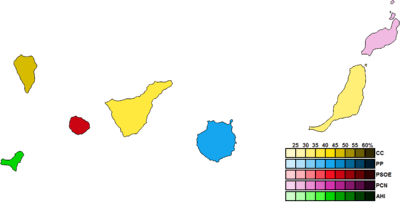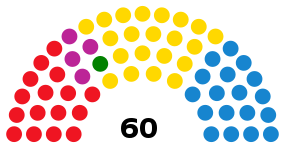Canarian regional election, 1995
|
| ||||||||||||||||||||||||||||||||||||||||||||||||||||||||||||||||||||||||||||||||||
| ||||||||||||||||||||||||||||||||||||||||||||||||||||||||||||||||||||||||||||||||||
All 60 seats in the Parliament of the Canary Islands 31 seats needed for a majority | ||||||||||||||||||||||||||||||||||||||||||||||||||||||||||||||||||||||||||||||||||
|---|---|---|---|---|---|---|---|---|---|---|---|---|---|---|---|---|---|---|---|---|---|---|---|---|---|---|---|---|---|---|---|---|---|---|---|---|---|---|---|---|---|---|---|---|---|---|---|---|---|---|---|---|---|---|---|---|---|---|---|---|---|---|---|---|---|---|---|---|---|---|---|---|---|---|---|---|---|---|---|---|---|---|
| Registered |
1,248,575 | |||||||||||||||||||||||||||||||||||||||||||||||||||||||||||||||||||||||||||||||||
| Turnout |
801,607 (64.2%) | |||||||||||||||||||||||||||||||||||||||||||||||||||||||||||||||||||||||||||||||||
| ||||||||||||||||||||||||||||||||||||||||||||||||||||||||||||||||||||||||||||||||||
 Constituency results map for the Parliament of the Canary Islands | ||||||||||||||||||||||||||||||||||||||||||||||||||||||||||||||||||||||||||||||||||
| ||||||||||||||||||||||||||||||||||||||||||||||||||||||||||||||||||||||||||||||||||
The 1995 Canarian regional election was held on Sunday, 28 May 1995, to elect the 4th Parliament of the Autonomous Community of the Canary Islands. All 60 seats in the Parliament were up for election. The election was held simultaneously with regional elections in twelve other autonomous communities and local elections all throughout Spain.
Overview
Electoral system
The Parliament of the Canary Islands was the devolved, unicameral legislature of the autonomous community of the Canary Islands, having legislative power in regional matters as defined by the Spanish Constitution and the Canarian Statute of Autonomy, as well as the ability to vote confidence in or withdraw it from a President of the Government.[1] Voting for the Parliament was on the basis of universal suffrage, which comprised all nationals over eighteen, registered in the Canary Islands and in full enjoyment of their political rights.
The 60 members of the Parliament of the Canary Islands were elected using the D'Hondt method and a closed list proportional representation, with a threshold of 20 percent of valid votes—which included blank ballots—being applied in each constituency. Parties not reaching the threshold were not taken into consideration for seat distribution. Alternatively, parties could also enter the seat distribution as long as they reached 3 percent regionally. Seats were allocated to constituencies, corresponding to the islands of El Hierro, Fuerteventura, Gran Canaria, La Gomera, La Palma, Lanzarote and Tenerife. Each constituency was allocated a fixed number of seats: 3 for El Hierro, 7 for Fuerteventura, 15 for Gran Canaria, 4 for La Gomera, 8 for La Palma, 8 for Lanzarote and 15 for Tenerife.[1]
The electoral law provided that parties, federations, coalitions and groupings of electors were allowed to present lists of candidates. However, groupings of electors were required to secure the signature of at least 1 percent of the electors registered in the constituency for which they sought election. Electors were barred from signing for more than one list of candidates. Concurrently, parties and federations intending to enter in coalition to take part jointly at an election were required to inform the relevant Electoral Commission within ten days of the election being called.[2][3][4]
Election date
The term of the Parliament of the Canary Islands expired four years after the date of its previous election. Elections to the Parliament were fixed for the fourth Sunday of May every four years. The previous election was held on 26 May 1991, setting the election date for the Parliament on Sunday, 28 May 1995.[1][2][3][4]
The Parliament of the Canary Islands could not be dissolved before the date of expiry of parliament except in the event of an investiture process failing to elect a regional President within a two-month period from the first ballot. In such a case, the Parliament was to be automatically dissolved and a snap election called, with elected deputies merely serving out what remained of their four-year terms.[1]
Results
Overall
 | ||||||||||
| Parties and coalitions | Popular vote | Seats | ||||||||
|---|---|---|---|---|---|---|---|---|---|---|
| Votes | % | ±pp | Total | +/− | ||||||
| Canarian Coalition (CC) | 261,672 | 32.83 | –3.93 | 21 | –2 | |||||
| Canarian Coalition (CC)1 | 261,424 | 32.80 | –3.90 | 21 | –2 | |||||
| Nationalist Canarian Initiative (ICAN)2 | 248 | 0.03 | –0.03 | 0 | ±0 | |||||
| People's Party (PP) | 247,609 | 31.07 | +18.24 | 18 | +12 | |||||
| Spanish Socialist Workers' Party (PSOE) | 183,969 | 23.08 | –9.95 | 16 | –7 | |||||
| Canarian United Left (IUC) | 40,614 | 5.10 | New | 0 | ±0 | |||||
| Nationalist Canarian Platform (PCN) | 23,914 | 3.00 | New | 4 | +4 | |||||
| Coalition for Gran Canaria (CGC) | 10,964 | 1.38 | New | 0 | ±0 | |||||
| Democratic and Social Centre–Centrist Union (CDS–UC) | 5,340 | 0.67 | –13.74 | 0 | –7 | |||||
| National Congress of the Canaries (CNC) | 2,964 | 0.37 | New | 0 | ±0 | |||||
| Popular Front of the Canary Islands–Awañac (FREPIC–Awañac) | 2,436 | 0.31 | New | 0 | ±0 | |||||
| Independent Herrenian Group (AHI) | 2,105 | 0.26 | +0.05 | 1 | ±0 | |||||
| Tinerfenian Assembly (ATF) | 1,600 | 0.20 | New | 0 | ±0 | |||||
| Humanist Party (PH)3 | 1,561 | 0.20 | +0.04 | 0 | ±0 | |||||
| Green Left of the Canary Islands (Izegzawen) | 1,357 | 0.17 | New | 0 | ±0 | |||||
| Communist Party of the Canarian People (PCPC) | 1,251 | 0.16 | New | 0 | ±0 | |||||
| Party of The People (LG) | 625 | 0.08 | –0.13 | 0 | ±0 | |||||
| Blank ballots | 9,078 | 1.14 | +0.37 | |||||||
| Total | 797,059 | 60 | ±0 | |||||||
| Valid votes | 797,059 | 99.43 | +0.16 | |||||||
| Invalid votes | 4,548 | 0.57 | –0.16 | |||||||
| Votes cast / turnout | 801,607 | 64.20 | +2.57 | |||||||
| Abstentions | 446,968 | 35.80 | –2.57 | |||||||
| Registered voters | 1,248,575 | |||||||||
| Sources[5][6][7] | ||||||||||
| ||||||||||
Distribution by constituency
| Constituency | CC | PP | PSOE | PNC | AHI | |||||
|---|---|---|---|---|---|---|---|---|---|---|
| % | S | % | S | % | S | % | S | % | S | |
| El Hierro | 5.1 | − | 26.7 | 1 | 23.0 | 1 | 43.0 | 1 | ||
| Fuerteventura | 31.3 | 2 | 26.5 | 2 | 26.9 | 2 | 10.5 | 1 | ||
| Gran Canaria | 27.5 | 5 | 40.2 | 7 | 18.0 | 3 | 3.3 | − | ||
| La Gomera | 35.5 | 2 | 8.9 | − | 47.0 | 2 | ||||
| La Palma | 45.6 | 4 | 20.0 | 2 | 27.4 | 2 | ||||
| Lanzarote | 17.1 | 1 | 19.0 | 2 | 25.2 | 2 | 29.8 | 3 | ||
| Tenerife | 39.2 | 7 | 24.6 | 4 | 27.0 | 4 | ||||
| Total | 32.8 | 21 | 31.1 | 18 | 23.1 | 16 | 3.0 | 4 | 0.3 | 1 |
Notes
References
- 1 2 3 4 "Statute of Autonomy of the Canary Islands of 1982". Organic Law No. 10 of 10 August 1982. Official State Gazette (in Spanish). Retrieved 12 September 2017.
- 1 2 "Electoral Matters Urgent Measures Law of 1987". Law No. 3 of 3 April 1987. Official Gazette of the Canary Islands (in Spanish). Retrieved 12 September 2017.
- 1 2 "General Electoral System Organic Law of 1985". Organic Law No. 5 of 19 June 1985. Official State Gazette (in Spanish). Retrieved 28 December 2016.
- 1 2 "Representation of the people Institutional Act". juntaelectoralcentral.es. Central Electoral Commission. Retrieved 16 June 2017.
- ↑ "Electoral Information System in the Canary Islands". parcan.es (in Spanish). Canarian Institute of Statistics. Retrieved 30 September 2017.
- ↑ "Parliament of the Canary Islands election results, 28 May 1995" (PDF). juntaelectoralcentral.es (in Spanish). Electoral Commission of the Canary Islands. 18 August 1995. Retrieved 30 September 2017.
- ↑ "Parliament of the Canary Islands elections since 1983". historiaelectoral.com (in Spanish). Electoral History. Retrieved 30 September 2017.
